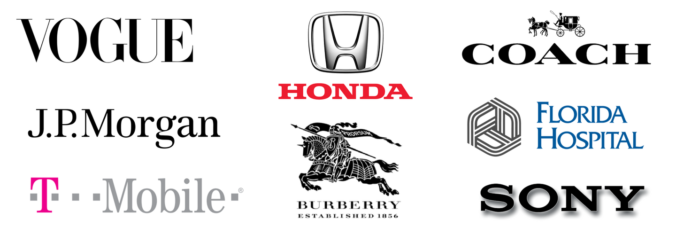Typography is one of the most integral aspects of brand identity. The right typeface effectively speaks about your brand’s personality, values, and professionalism at a single glance.
Poor selection of type can water down or misrepresent your message. This extended guide will take you through an art-and-science walkthrough for selecting brand fonts while giving valuable insights into the key typography design principles and strategies of font pairing, among many more.
Why Typeface Selection Matters in Branding
Typography is more than just words on a page; it’s a visual representation of your brand’s voice. Be it on your website, logo, or marketing materials, the typeface you choose shapes first impressions and sets the tone for your brand.
Key reasons to pay attention to brand font selection:
1. Typography sets brand personality. Fonts are a way to show mood and style; for instance, serif fonts like Times New Roman project tradition and authority, while sans-serif fonts, such as Helvetica, are clean and modern.
2. Principles of good typography design ensure that your text is readable on different devices and mediums.
3. Consistency in font helps in brand recognition and makes the brand look polished.
4. Distinguishes Your Brand: Unique font styles or custom fonts for brands help you stand out in a competitive market.
The Basics of Typeface Selection
Selecting the perfect typeface is a crucial step in shaping your brand’s visual identity. Fonts communicate tone, personality, and values, making them integral to effective branding.
To choose the right fonts, start by understanding the different font categories and their applications:
1. Serif Fonts
Features: Small lines or strokes attached to the ends of letters.
Best For: Traditional and formal brands, such as law firms or luxury goods.
Examples: Times New Roman, Garamond.
2. Sans-Serif Fonts
Features: Clean lines without embellishments.
Best For: Modern and minimalist brands.
Examples: Arial, Helvetica, Futura.
3. Script Fonts
Features: Handwritten or calligraphic styles.
Best For: Elegant or creative brands.
Examples: Brush Script, Lobster.
4. Display Fonts
Features: Highly stylized and attention-grabbing.
Best For: Headlines and logos.
Examples: Impact, Bebas Neue.
5. Monospace Fonts
Features: Uniform character spacing.
Best For: Tech or coding-related brands.
Examples: Courier, Consolas.
Typography Design Principles for Brands
Typography plays a pivotal role in establishing a brand’s identity and conveying its message effectively. The right font choice can evoke emotions, build trust, and leave a lasting impression.
When choosing brand fonts, here are the basic typography tips to remember for a brand:
1. Legibility and Readability
Ensure that fonts are readable across devices and platforms. Avoid using overly decorative fonts for body text.
2. Brand Alignment
Match the personality of the font to the personality of your brand. A playful startup could make use of rounded sans-serif fonts, while a corporate brand will require sleek serif fonts.
3. Scalability
Your fonts need to look good from the tiniest size on the business card to huge sizes on billboards.
4. Flexibility
Choose one font family that has multiple weights to maintain the variation in design, such as light, bold, italic, etc.
How to Choose a Font for Your Brand
Choosing the right font for your brand is a critical step in establishing your identity. A well-chosen typeface can evoke emotions, build recognition, and convey your brand’s personality. It’s more than aesthetics; it’s about ensuring your message resonates effectively with your target audience. Following are the steps one has to follow for effective typeface selection:
1. Describe Your Brand Personality
Is your brand modern, playful, serious, or luxury? The answer will guide your font choices.
2. Competitor Research
Go back to your competitors’ typography. Note what works and where you can differentiate.
3. Test Font Pairing for Branding
Mix two complementary fonts, usually one for headings and another for the body. For example, one can use a serif font combined with a sans-serif font to achieve contrast.
4. Test Various Font Styles for Professional Branding
Make mock-ups of different font styles on your logo, website, and marketing materials to see how they fit into your vision.
5. Get Feedback
Get input from stakeholders, designers, and even customers. Sometimes fresh eyes can confirm your decisions.
Importance of Typography in Branding
Typography is an essential part of visual communication. Besides aesthetic appeal, it serves a number of other important purposes:
1. Building Trust: Professional fonts lend to credibility, and poorly chosen fonts can make your brand seem amateurish.
2. Driving Engagement: Modern fonts for logos and marketing materials catch the eye and invite interaction.
3. Reinforcing Messaging: Typography amplifies the tone and meaning of your words.
A branding agency Canada could, for instance, use clean, modern fonts to give off a professional and innovative feel.
Trends in Typeface Selection
Typography trends evolve to reflect modern aesthetics and audience preferences. Staying updated ensures your brand feels fresh, relevant, and visually appealing. From minimalist sans-serif designs to bold, expressive fonts, leveraging current typeface trends can help your brand make a striking and memorable impression in a competitive landscape. Stay ahead by incorporating these trends into your branding:
1. Minimalist Typography
Clean and simple fonts remain timeless and versatile, effortlessly blending with various design aesthetics while ensuring readability and leaving a professional impression across digital and print platforms.
2. Custom Fonts for Brands
Crafting a bespoke typeface gives brands a unique and exclusive identity, aligning with their personality and creating a strong, memorable connection with their target audience.
3. Variable Fonts
These adaptable fonts dynamically adjust to different screen sizes and resolutions, ensuring consistent readability and an optimized user experience across diverse devices and interfaces.
4. Retro Fonts
Vintage-inspired fonts add a nostalgic charm and creative flair, making them an ideal choice for brands aiming to stand out or evoke emotional connections.
5. Font Pairing Tips for Effective Branding
Combining fonts strategically enhances branding. Consider contrast, visual hierarchy, and harmony to communicate your brand’s message while maintaining a polished and cohesive design.
6. Contrast is Key
Pair fonts with distinct yet complementary styles, such as a bold sans-serif for impactful headings and a refined serif for elegant, readable body text.
7. Limit Your Choices
Using only two or three fonts ensures visual consistency, prevents design clutter, and helps maintain a professional and streamlined appearance in your branding materials.
8. Use Tools
Leverage tools like Google Fonts and Adobe Fonts for expert font-pairing suggestions, simplifying the selection process while ensuring visually pleasing and harmonious typography.
Examples of Successful Brand Typography
Successful brands carefully choose typography that reflects their identity and resonates with their audience. From timeless classics to modern custom fonts, each selection tells a story.
Here are a few inspiring examples of brands that have mastered the art of typography:
1. Coca-Cola
The brand uses a custom script font with flowing, elegant curves to evoke timelessness, authenticity, and a sense of nostalgia
2. Google
It employs a clean, modern sans-serif font that embodies simplicity, approachability, and versatility, ensuring accessibility across diverse digital platforms.
3. New York Times
The publication relies on classic serif fonts with sharp details, emphasizing tradition, authority, and credibility within journalism and media.
Common Mistakes in Choosing Brand Fonts
Selecting the right fonts is crucial, but it’s easy to fall into common pitfalls. Poor font choices can weaken your brand’s message and confuse your audience. Avoid these mistakes to ensure consistency and clarity in your branding efforts:
Too Many Fonts: Too many fonts can make your audience confused and overwhelmed.
Ignoring Readability: Some fancy fonts look good but may be hard to read.
Inconsistent Usage: To maintain a cohesive look across all brand materials, it is best to use only your set of chosen fonts.
Conclusion: How to Create Your Brand’s Visual Identity
Font selection is a part of branding and should be treated as such. Take the time to learn the principles of typography design, have some fun matching fonts, and stay true to your brand’s personality-the reward will be a consistent, bold identity.
At Tribe and Tales, we pride ourselves on the ability to help businesses like yours create stunning visual identities-from PR for brand awareness, through brand storytelling, to social media services. Let’s design a typography strategy that speaks volumes for your brand!

A Marketing Communications and Advertising professional, I have worked across some of the biggest agency conglomerates like Publicis and WPP, handling the Communications mandate for brands like Shaadi.com, Reliance Fresh, Tanishq, Netflix and more.

Leave a Reply